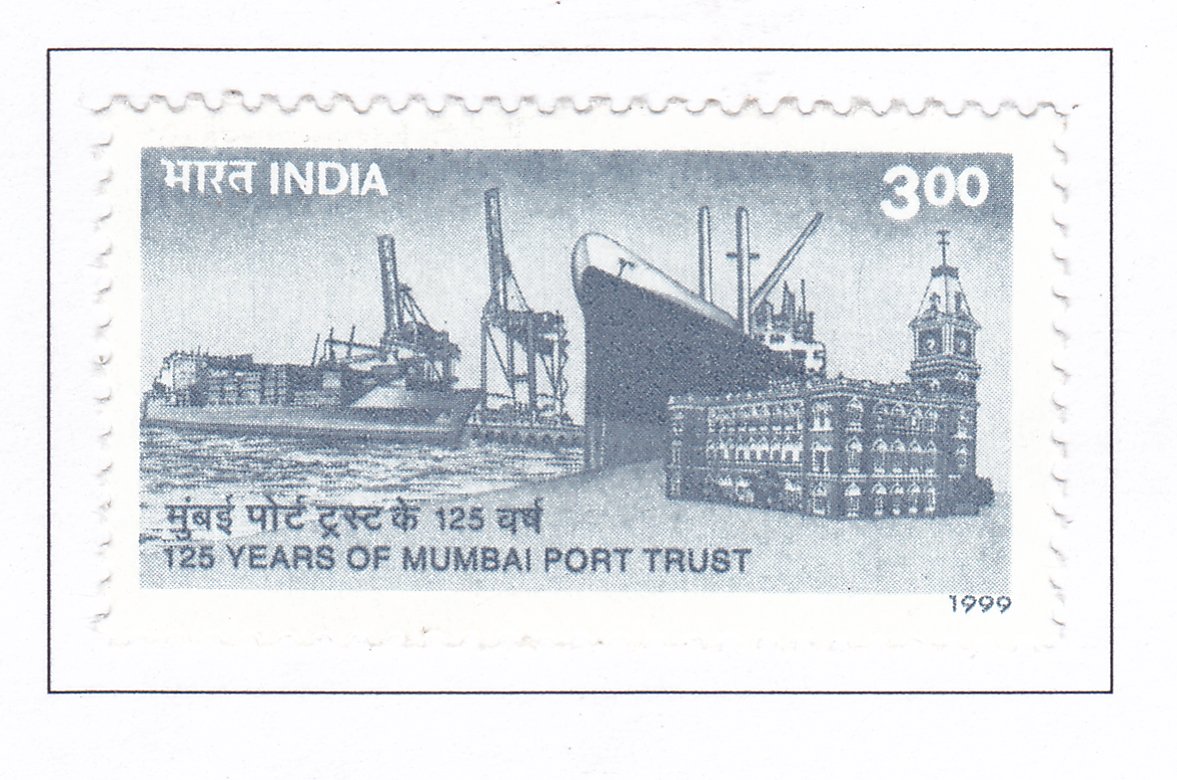Mumbai Port Trust – 125th Anniversary

Technical Data
| Date of Issue | June 26, 1999 |
|---|---|
| Denomination | Rs. 3 |
| Quantity | 700,000 |
| Perforation | comb 13 |
| Printer | Security Printing Press, Nashik |
| Watermark | No Watermark |
| Colors | Slate blue |
| Catalog Codes |
Michel IN 1686 Stamp Number IN 1747 Yvert et Tellier IN 1453 Stanley Gibbons IN 1849 |
| Themes | Anniversaries and Jubilees | Ports | Ships |
Table of Contents
Commemorative Stamp Set: Mumbai Port – Gateway of India
Design Elements:
- Port and Harbor Imagery: The stamp prominently features an artistic representation of Mumbai Port, showcasing its sprawling natural harbor, ships, and cranes, symbolizing its role as a critical hub for trade and commerce.
- Gateway of India: A depiction of the iconic Gateway of India structure is included to emphasize Mumbai Port’s historical significance as the nation’s entry point to the outside world.
- Historic Date: The stamp includes the date “26.06.1873” to mark the establishment of the Mumbai Port Trust.
Cultural and Historical Significance:
- Strategic Location: Mumbai Port, situated at the mid-point on India’s west coast, has historically been a crucial link for maritime trade, making it a vital part of India’s economic history.
- Premier Port: As India’s leading port for several decades, it has played a pivotal role in facilitating international trade and commerce, serving as the country’s primary maritime gateway.
- Historical Context: The port’s establishment in 1873 was a strategic move to protect trade interests and prevent monopolistic practices by private companies, ensuring the port’s development as a public utility.
Usage:
- Celebrating Maritime Heritage: The stamp is ideal for commemorating events related to India’s maritime history, trade, and infrastructure development.
- Educational Purposes: It can be used to educate the public about the historical importance of Mumbai Port and its contributions to national trade.
- Philatelic Collections: A valuable addition to collections focusing on India’s infrastructure, maritime history, or iconic landmarks.
Importance of the Commemorative Stamp Set:
- Recognition of Economic Contribution: The stamp set highlights the significant role Mumbai Port has played in shaping India’s trade and economic landscape.
- Historical Legacy: It commemorates the port’s legacy as a gateway that connected India to global markets, reflecting its enduring importance over the decades.
- Promotion of National Pride: By celebrating Mumbai Port, the stamp set fosters national pride in India’s maritime achievements and infrastructure development.
Example of the Stamp Design:
- Central Port Imagery: The stamp design features a detailed portrayal of Mumbai Port, with ships, cargo handling equipment, and the natural harbor to reflect its operational scale.
- Gateway of India Symbol: The Gateway of India is prominently depicted, symbolizing Mumbai’s status as a historical entry point to India.
- Historical Date: The date of the establishment of the Mumbai Port Trust (26.06.1873) is inscribed to highlight its historical foundation.
The Commemorative Stamp Set Might Include:
- Series Depicting Port Evolution: A series of stamps illustrating the evolution of Mumbai Port from its early days to its current status as a modern port facility.
- Key Landmarks: Stamps featuring other key landmarks and facilities within Mumbai Port, such as the docks, warehouses, and lighthouses, showing the port’s infrastructure.
- Significant Events: Stamps commemorating important events in the port’s history, such as the first major shipment, expansions, and technological advancements.
Significance:
- Economic Backbone: The stamp set signifies Mumbai Port’s role as an economic backbone of India, crucial for international trade and commerce.
- Historical Importance: It serves as a reminder of the port’s long-standing contribution to India’s development, marking it as a historic and strategic asset.
- Global Connectivity: The stamps underscore Mumbai Port’s role in connecting India with the rest of the world, reinforcing its title as the “Nation’s Window to the Outside World.”
